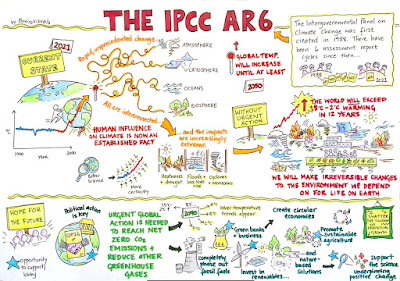Earlier this month we promised (threatened?) to share more resources related to understanding and responding to the Intergovernmental Panel on Climate Change’s [IPCC] recent report. Yesterday we suggested that taking a careful look at YES! magazine’s How Much Is Enough? online coverage is strongly recommended. Today we spent some time looking at some of the sources they cite because, quite frankly, we have no idea what in hell per capita use of 1300 watts, compared to 9000 watts, actually translates to in the real world. In the process, we found some interesting, and potentially helpful, resources. But, before we get to them, here’s a resource that was shared in response to a Tweet we made yesterday about communicating science so real folks can understand what’s the message.
 |
| click to bigify and see source |
Now, one information and analysis source of which we weren’t previously aware is the International Energy Agency’s World Energy Model, in particular the Sustainable Development Scenario which relates energy development to the United Nation’s Sustainable Development Goals. (To be candid, we’ve read some allegations that the IEA isn’t always the sharpest tool in the shed, so we take their conclusions with some skepticism.) Closing this particular loop, the YES! assessment notes
For energy distribution, researchers at the International Institute for Applied Systems Analysis say the minimum global energy flow required to achieve universal decent living standards could be as low as 500 watts per capita. Less draconian, the International Energy Agency projects that the U.N.’s Sustainable Development Goals can be achieved worldwide with an energy flow of about 1,300 watts per capita—about what Cuba uses.
Being the curious type, and long a student and proponent of Systems Analysis, we went to the IIASA web site and discovered, inter alia, their Defense of the natural realm. It’s among the few pieces of better, if not actually good, news we’ve encountered this week. [We know, it’s only Tuesday.]
Options Magazine, Summer 2021: At a crucial moment for beleaguered nature, IIASA research is showing that we can reverse biodiversity loss. It will need an effort that is grand in scale and focused where rewards are greatest.
Perhaps it is a coincidence, perhaps a sign of changing times, but we don’t find it to be too much of a stretch to conclude that the IIASA biodiversity showing aligns nicely with information we learned last night during a webinar hosted by Trout Unlimited [TU], an organization to which we’ve belonged for most of our adult life. TU was announcing their strategic plan update. Here’s a hint
A New Direction.
The harder we work, the more we realize how much work remains.
So we’re retooling, recruiting, and reinforcing. With a new strategic direction over the next five years and beyond, we will build on the great work of those who came before us.
We will recruit a larger, younger, and more diverse array of communities and conservation advocates willing to roll up their sleeves.
It’s beginning to look as though there may be more of US than there are of those who would do little more than exploit the Earth to enrich themselves. That’s something I want to believe!
Trout
I do my bestto keep pointlessnessat bay. But here,wet above myknees, I let it fly.Here, hot and cold,fingers thick withthinking, I try totie the fly and lookfor the net, looseningthe philosophicalknot of why I camehere today, not yetknowing whetherI’ll free or frythe rainbowsand browns oncethey’re mine.
********************************************
Thanks for visiting. Come again when you can.
Please be kind to each other while you can.
No comments:
Post a Comment